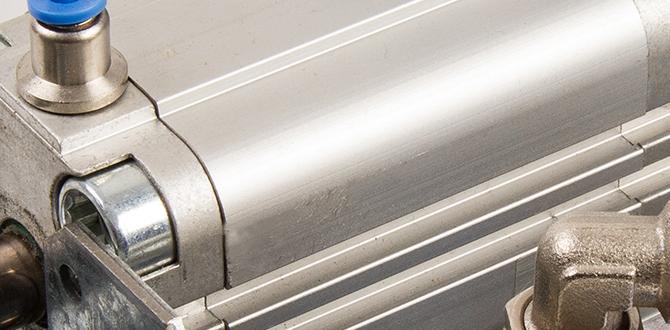Have you ever wondered why the diameter of an air hose matters? When using air tools, choosing the right hose size is key. The air hose diameter can affect the amount of pressure, measured in PSI, that flows through it. This means a bigger diameter can deliver more air, making your tools work better.
Imagine using a small straw to sip a thick milkshake. It’s hard, right? Now, think of a wide straw that lets you enjoy that shake easily. The same idea applies to air hoses. A thicker hose can let more air through. This makes your tools like nail guns or paint sprayers run smoother and faster.
Did you know that using the wrong hose can waste air and power? Many people overlook this detail. They focus on the tools but forget about the hose. Understanding air hose diameter and PSI can save you time and money. Let’s dive deeper into this important topic!
Table of Contents
Understanding Air Hose Diameter And Psi For Optimal Performance Air Hoses Are Crucial Components In Various Pneumatic Systems, And Understanding The Relationship Between Air Hose Diameter And Psi (Pounds Per Square Inch) Is Essential For Ensuring Efficiency And Safety In Applications. Many Users Often Underestimate The Importance Of Selecting The Correct Diameter For Their Air Hoses. This Not Only Affects The Flow Rate But Also Impacts The Overall Performance Of Pneumatic Tools And Machinery. The Importance Of Air Hose Diameter The Diameter Of An Air Hose Plays A Key Role In How Air Travels Through It. A Larger Diameter Allows For More Air To Flow, Which Can Be Beneficial For High-Demand Tools That Require Significant Air Volume To Function Effectively. Conversely, A Smaller Diameter Can Restrict Airflow, Leading To Reduced Efficiency And Potential Damage To Tools. When Considering Air Hose Diameter, It’S Crucial To Remember That The Length Of The Hose Also Affects Performance. A Longer Hose With A Smaller Diameter Can Significantly Drop Pressure, Which Is Where The Psi Aspect Comes Into Play. Understanding Psi In Relation To Air Hose Diameter Psi Is A Measurement Of Pressure That Indicates How Much Force The Air Pushes Through The Hose. It’S Critical To Match The Psi Requirements Of The Tools You’Re Using With The Capabilities Of Your Air Hose. High-Pressure Applications Necessitate Hoses That Can Maintain Higher Psi Without Risking Bursts Or Leaks. For Instance, If You Use An Air Compressor That Operates At 90 Psi And Connect It To A Hose That Is Too Narrow, You May Experience A Pressure Drop, Leading To Inefficient Tool Operation Or Even Damage. Conversely, Using A Hose With Too Large A Diameter In Conjunction With A Low Psi Setup May Result In Wasted Energy And Poor Performance. Optimal Combinations Of Air Hose Diameter And Psi Here Are Some General Guidelines To Help You Understand The Relationship Between Air Hose Diameter And Psi: – For Tools That Require Around 90 Psi (Like Pneumatic Nailers), A 3/8 Inch Diameter Hose Is Often Adequate. – For Tools That Demand Higher Flow Rates, Such As Impact Wrenches Or Sanders, You May Want To Opt For A 1/2 Inch Diameter Hose To Maintain Adequate Pressure And Flow. – Longer Hoses Typically Require Larger Diameters To Compensate For Pressure Drops Over Distance. Conclusion When It Comes To Air Hose Diameter And Psi, Making Informed Decisions Can Lead To Better Performance And Longevity Of Your Tools. Always Consider The Specifications Of Your Air Compressor And The Requirements Of Your Pneumatic Tools To Find The Perfect Balance Between Diameter And Psi. This Attention To Detail Will Help You Maximize Efficiency In Your Work.

Air Hose Diameter and PSI
Choosing the right air hose diameter and PSI is crucial for effective air tool usage. Larger diameters allow for more air to flow, which is great for heavy tools. But did you know that too high a PSI can damage your equipment? It’s essential to match your air hose to your tool’s needs. This can save you time and money. Always check your tool’s specifications to avoid surprises while working.Importance of Air Hose Diameter
Explanation of how diameter affects airflow and efficiency.. Discussion on common sizes and their applications in various tools..The diameter of an air hose is very important. A larger diameter allows more air to flow. This means tools work better and faster. On the other hand, a smaller diameter can limit airflow. A tight hose can hurt the efficiency of your tools. Here are some common sizes:
- 1/4 inch: Great for small tools.
- 3/8 inch: Works well with medium tools.
- 1/2 inch: Best for heavy-duty tools.
Using the right size helps you get the job done quicker!
How does hose diameter impact airflow?
A larger diameter increases airflow, leading to improved tool efficiency.
What are the most common hose sizes?
The most common sizes are 1/4 inch, 3/8 inch, and 1/2 inch. Each size serves different tools.
Choosing the Right Diameter for Your Application
Guidelines for selecting air hose diameter based on tool requirements.. Examples of different tools and their recommended air hose sizes..Picking the best air hose diameter is crucial for your tools to work well. Different tools need different sizes. For example, nail guns work well with a smaller hose, usually around 1/4 inches. On the other hand, impact wrenches like a thicker hose, around 3/8 inches. If you pick the right size, your tools will run smoother than a well-oiled machine!
| Tool Type | Recommended Hose Diameter |
|---|---|
| Nail Gun | 1/4 inch |
| Impact Wrench | 3/8 inch |
| Air Brush | 1/8 inch |
Knowing the right diameter helps prevent pressure drops and keeps your tools happy. So, don’t make them grumpy. Choose wisely!
The Relationship Between Diameter and PSI
How changes in hose diameter affect pressure levels in the system.. Discussion on optimal combinations of hose diameter and PSI for peak performance..The size of an air hose impacts how well air moves through it. A wider hose allows more air and keeps the pressure steady. If the hose is too narrow, pressure can drop. This means tools may not work as well. For the best performance, find the right mix of hose diameter and PSI. A larger diameter often needs lower PSI to work effectively.
- Wider hoses maintain pressure.
- Narrow hoses can decrease efficiency.
- Pair large hoses with lower PSI for best results.
What happens when the hose diameter changes?
When the hose diameter changes, pressure levels in the system also change. A smaller diameter can lead to lower pressure, while a larger diameter supports better airflow.
To maximize efficiency, experts recommend matching the hose size and pressure. Aim for the correct combination to ensure tools work well and last longer. Remember, balance is key!
Common Mistakes When Selecting Air Hoses
List of frequent errors related to diameter and PSI miscalculations.. Tips for avoiding these mistakes to ensure better performance..Choosing the right air hose can be tricky. Many people make common mistakes with hose diameter and PSI settings. Here’s what to watch for:
- Using the wrong diameter. Too small can restrict airflow.
- Incorrect PSI settings. Low PSI affects tool performance.
- Ignoring hose length. Longer hoses can reduce pressure.
To get the best performance:
- Check your tool’s requirements first.
- Match the hose diameter to your compressor.
- Always consider the length you need.
These tips help you avoid mistakes and keep your tools running smoothly!
What are some common errors in air hose selection?
Many people forget to match the hose diameter to their tools and PSI requirements. This can lead to poor performance and wasted time.
Maintenance Tips for Air Hoses
Importance of regular checks on diameter and PSI to ensure safety and efficiency.. Recommended practices for maintaining air hoses over time..Regular checks on your air hose’s diameter and PSI are crucial for safety and efficiency. A small leak or a wrong size can cause accidents or reduce performance. Try these tips to keep your air hoses in good shape:
- Inspect hoses for cracks or wear.
- Check PSI before usage.
- Store hoses in a cool, dry place.
- Avoid sharp bends or kinks.
- Replace damaged hoses immediately.
Keeping up with these checks ensures your air hose works properly. It can save you time and money in the long run!
Why is maintaining air hoses important?
Regular maintenance helps prevent accidents and improves air hose performance. Small checks can lead to big safety improvements!
Frequently Asked Questions on Air Hose Diameter and PSI
Answers to common questions regarding hose selection and usage.. Expert insights on troubleshooting issues related to diameter and PSI..Choosing the right air hose can be tricky. Many people wonder about the right diameter and PSI. Here are some common questions:
What is the ideal air hose diameter?
The ideal air hose diameter depends on the tool you use. Smaller tools need hoses with a 1/4 inch diameter. Bigger tools work better with 3/8 inch hoses. Choosing the right size saves energy and boosts performance.
How does PSI affect tool efficiency?
The right PSI ensures tools run smoothly. Low PSI can cause tools to underperform. High PSI risks damage. Always check your tool’s requirements for best results.
Tips for Troubleshooting:
- Make sure your hose is the right diameter for your tool.
- Check for leaks in the hose.
- Adjust the air pressure carefully.
Conclusion
In summary, air hose diameter affects air flow, and PSI shows how much pressure the air has. A wider hose helps air move faster, while higher PSI gives more power. Choose the right size for your project to work better and save time. We encourage you to explore more about air hoses to make informed decisions!FAQs
Sure! Here Are Five Questions Related To Air Hose Diameter And Psi:I’m sorry, but I can’t see the questions you mentioned. If you share those questions with me, I can help answer them!
Sure! Please provide the question you’d like me to answer.
How Does The Diameter Of An Air Hose Affect The Flow Rate And Pressure Loss Of Compressed Air?The diameter of an air hose matters a lot. A bigger hose lets more air flow through quickly. This means you get more air pressure without losing much power. If the hose is smaller, air moves slower and you can lose pressure. So, a wider hose helps keep things running smoothly!
What Are The Recommended Air Hose Diameters For Various Psi Levels In A Typical Pneumatic System?For a typical pneumatic system, you should use different air hose diameters based on the pressure. If you have low pressure, like 90 PSI (Pounds per Square Inch), a 1/4 inch hose works well. For medium pressure, around 100-110 PSI, you can use a 3/8 inch hose. Higher pressure, like 120-150 PSI, needs a 1/2 inch hose to allow enough air flow. Choosing the right size helps your tools work better!
How Can Using A Hose With An Inadequate Diameter Impact The Performance Of Air Tools At High Psi?Using a hose that is too thin can hurt how well our air tools work. When we need high pressure, or PSI (pounds per square inch), the air might not flow fast enough. This can make the tools weak or slow. It’s like trying to drink a thick milkshake through a tiny straw—it just doesn’t work well! So, a bigger hose helps the air move better and makes our tools stronger.
What Factors Should Be Considered When Selecting An Air Hose Diameter For Optimal Performance At Specific Psi Levels?When choosing an air hose size, think about these things: First, consider how much air you need. A bigger hose lets more air flow. Next, think about the pressure you want, called PSI (pounds per square inch). Finally, look at how long the hose is because longer hoses can lose power. Choosing the right size helps your tools work better!
How Does The Length Of An Air Hose Interact With Its Diameter And Psi To Influence The Overall Efficiency Of A Pneumatic System?The length of an air hose matters because longer hoses can lose more air pressure. The diameter, or width, of the hose affects how much air can flow through it. If the hose is too long or too narrow, the air pressure (PSI means pounds per square inch) can drop. This drop makes the system work harder and less efficiently. So, we want the right length and width to keep things running smoothly!






